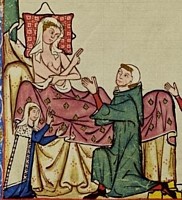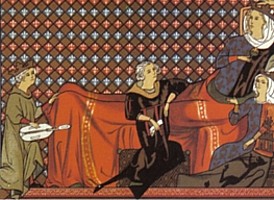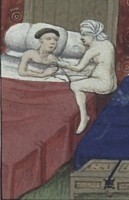|

Sleepwear
SLEEPING - SOCIALISING - PROCREATING - BIRTHING
- CONVALESCING
What did the medieval woman wear to bed? Generally it depended
on the circumstance of her being in bed. Was she there to sleep,
procreate, give birth or was she unwell and convalescing?
 Sleeping Sleeping
It seems that the usual thing for a woman to do when sleeping,
was to sleep naked- naked except for some kind of head covering.
The latest medical thinking believed that much of the body's heat
was lost through the head and that for the sake of one's health,
the head should remain covered.
Most images show this. It might be a veil, head wrap, coif or
even hairnet.
The image at the right comes from a German manuscript, the Manesse
Codex, in the early 14th century and shows a man who is besheeching
his lady love. She is already in bed, wearing nothing but a veil.
The prescence of her chamber maid suggests that this was not an
unusual or unseemly thing.

Socialising
Wealthy medieval ladies often socialised in their bedrooms or
solars, and when this occurred, a certain richness of dress would
be retained.  A
lady might wish to remain snuggly warm on a very cold winter's
day, but that's no reason to be any less elegantly dressed. A
lady might wish to remain snuggly warm on a very cold winter's
day, but that's no reason to be any less elegantly dressed.
This miniature is from the
13th century, "Queen Blanche of Castile With Attendants."
She herself is wearing a heraldic gown and so is the smaller woman
to her side. Both have veils and coronets- a crown in the case
of the queen. The queen also wears a brooch, something not necessary
for bedwear, showing that she has dressed in a manner suitable
for receiving visitors.
There is a guest with a scroll
in his hand casually leaning on the bed, hinting at a certain
amount of familiarity with the queen. The musician at the foot
of the bed also wears a coronet, although it is likely that one
of the two smaller people wearing coronets could be her child.
The similar heraldry hints that there may be a family connection.

Birthing
When images of a woman giving birth are shown, she is certain
to be only partially naked.
The image at right is dated at 1435, by Uccello, The Birth
of the Virgin. She wears a loose, green gown, fitted at the
wrist and has her head modestly wrapped in a cloth.
Scenes depicting a newborn baby, freshly washed and wrapped in
a towl and ready to be presented to the new mother usually show
the mother fully clothed, which purposts medieval mothers incredibly
quick to rise, attend to her post partum needs, dress and return
to bed.
In reality, the images are more likely to show a new mother well
after the birth itself.

Convalescing
in bed
Convalescing following illness or birth always shows a woman completely
dressed, often in loose-fitting clothes, but usually in her regular
day clothes.
The image above at the right shows The Birth of the Virgin
in 1435 by Uccello. With the baby freshly washed and the mother
already dressed in a loosely-fitting gown, her female attendants
are bringing food and drink.
Women who were unwell were usually attended by other women.

 Procreating Procreating
When in bed for the purpose of having babies, there is no clothing
worn other than the hat or headscarf to keep the head warm and
prevent sudden heat loss through the head due to the energetic
activity taking place.
As usual, both parties are naked. The concept of cute lingerie
especially worn for wooing in the bedroom does not exist in the
medieval period.
Notions that under every gown lies a sexy, laced leather corset
or metal chastity belt are entirely wrong. It appears that even
underpants were discarded at night.
For further, more information, visit SEX
LIVES- Sex, contraception and sexual health. Please note:
adult themes

Copyright
© Rosalie Gilbert
All text & photographs within this site are the property of
Rosalie Gilbert unless stated.
Art & artifact images remain the property of the owner.
Images and text may not be copied and used without permission.
|